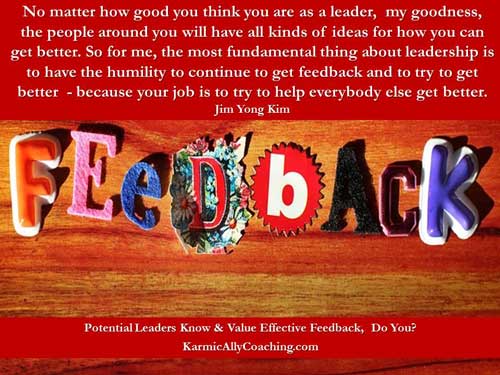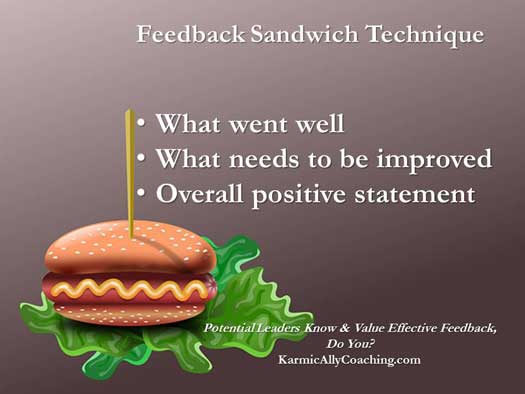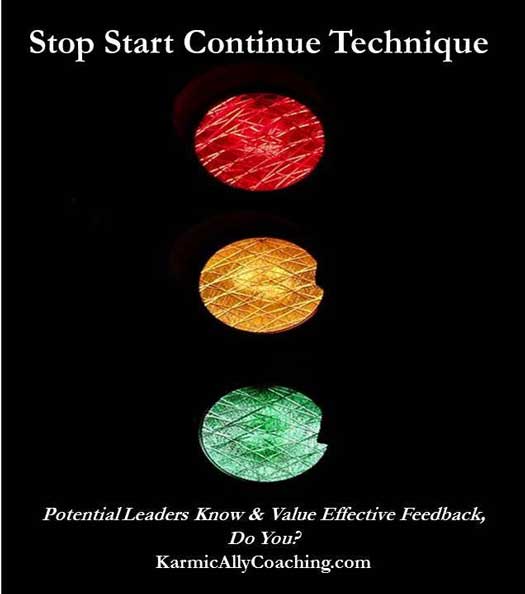This post has already been read 4577 times!

Feedback appears to be a highly misunderstood concept despite the fact that in any communication between 2 people, there will be times when each person is giving and receiving feedback.
Quite often managers think that they are the only ones who are supposed to give feedback to their team members. In fact, effective feedback is a 2 way communication that benefits both sides.
I shared a light moment in my blog post about the Monday Morning Basher Manager who misunderstood the Sandwich Feedback Technique (more on how to use this technique later) and terrorized his team.
The truth is, if we wish to really create change we not only need to know how well we are doing but also where we may be falling short and then create a plan to overcome our blind spot.
Giving feedback is not the exclusive domain of the manager although it may seem so at times.
A motivated team too provides feedback to the leader and other team members helping each one do better than they would have in the absence of feedback.
The ability to give and receive feedback is an indicator of leadership potential and a skill that you must develop if you want to rise up the corporate ladder.
Feedback is found in other areas of our life too.
Think back to your school days and the preparations that were done for the Annual Day function. Whether you were participating in a song, dance or play, different teachers would drop in during rehearsals and give suggestions that were open to discussion before implementation.
There would be a full dress rehearsal where again suggestions would be given and discussed and implemented if found practical.
I admit it would have been irritating at the time but the sound of thunderous applaud from the parents was well worth it.
You might have noticed that you and your peers who got the most compliments afterwards had at least one of these 2 habits.
They were open to receiving feedback and asking for advice, and/or
They gave timely, helpful and critical feedback in a constructive manner.
Transfer these 2 habits into a corporate setting and you demonstrate leadership potential
Executive Presence and Leadership potential aren’t just trending words in the corporate world.
Studies have shown that high performing professionals may fall short of climbing the rung up the corporate ladder because they lack these qualities and companies invest thousands to train employees who have caught their eye as having potential.
The 2 habits I mentioned are actually among those that indicate leadership potential and you can check if you have the habits that will raise your visibility with Karmic Ally Coaching’s Executive Presence Checklist.
During my time in audit, we used to have team meetings at the beginning of the assignment to brainstorm an effective strategy and decide how we would deliver our work to the client in the most efficient and effective manner.
After the audit assignment was completed, we’d have debriefing meetings where the entire team including the partner would go over our performance as a team and note down what we did well, where we might have slipped and how we could do better the next year.
Minutes of these meetings were recorded and distributed to the team members. A copy was filed to be taken forward for the next year’s assignment.
This precious document was created with input from all team members after dialogue and discussion.
That’s how effective feedback in a team situation works.
The Partner would learn about the challenges his team might have faced so he could discuss it with the client and negotiate additional fees for cost overruns. He’d also share insights that the manager and team would apply in future for similar assignments.

At an individual level, the feedback would continue in the form of appraisals with the team member and manager completing the engagement appraisal form, discussing it and sending it to Human Resources for future professional development needs and to record performance for the year.
More importantly, the habits of the team members were recorded in their individual performance reports and those that demonstrated openness to receiving feedback and participating in discussions were noticed for further responsibility with relevant training.
9 qualities of effective feedback
In all these situations and scenarios, there are 9 qualities that differentiate effective feedback from simple advice.
Effective feedback
- Is based on an objective or is referenced to a goal
- Is provided on a timely basis
- Is based on observation
- Focuses on behaviour, not on perceived attitudes
- Focuses on behaviour which can be changed
- Focuses on what the individual did well and what they could do better
- It is useful, concrete, specific and provides information that can be acted upon
- It is consistent in delivery and doesn’t change with the mood of the feedback giver
- If it involves personal performance, it is given in private (like the performance review)
How to give effective feedback
There are different methods of delivering feedback and their effectiveness depends upon the situation and the openness of both the feedback giver and receiver in having a dialogue aimed to achieve a goal.
In this post, I’m sharing 3 techniques.
Feedback Sandwich Technique
This technique is well-known and is used in performance appraisal sessions as well as in Executive Coaching and other coaching practices.
Feedback Sandwich is a 3 stage process. The picture below sums up the technique.

On paper this is a simple process but it has 1 major disadvantage – the receiver may hear the first and last part of the feedback and completely miss the important middle part about what needs to be improved.
You can overcome this disadvantage by asking the receiver about their views on what needs to be improved to make it a dialogue.
Stop, Start Continue Technique

In this technique, you engage the receiver in the discussion by asking them
- What they feel they should stop doing
- What they feel they should start doing
- What they wish to continue doing
The person receiving the feedback might also want to give you some feedback.
Make sure you are open to suggestions, actively listen to them and ask questions to get a better understanding of their comments and then discuss the feedback.
Effective Feedback Cycle

This technique has been found to be effective in executive coaching and one that I also use with my clients. It involves active participation by both the feedback giver and receiver.
There are 5 phases in this technique
Observation: where the feedback giver provides a summary of what he has seen or heard
Statement of Effect: where the receiver is made aware of the action or behaviour and the impact it has had
Shared Insights: discussion between the giver and receiver about the action and impact with both sides sharing their insights
Suggestions for Action: where the feedback giver provides actionable suggestions about alternative courses of action to enable the receiver to determine which ones would work for them
Questioning: The feedback giver asks open questions to move the receiver forward towards deciding on the plan of action.
The receiver is an active participant in the feedback process and has the opportunity to present his perspective during the phases of shared insights, suggestions for actions and may even ask questions to gain clarity about the action plan before agreeing to it.
It is also an opportunity for the feedback giver to learn more about themselves and their style and improve their own performance and objective of helping the other person.
Different techniques work in different situations and as the feedback giver, you need to apply your professional judgement and take into account how the receiver will respond.
Professionals who are able to give and receive feedback without making it personal or judgemental and are willing to be creative display good emotional intelligence and people skills. That’s always a brownie point if you want to be seen as a Leader.
Add to the conversation by telling me about your method of giving feedback and how you prefer to receive feedback in the comments box below!
Effective Feedback is just one of the skills and habits that are indicators of leadership potential and executive presence. You can download the entire checklist to assess how you measure up for free. Scroll down for the sign up form if you prefer staying on this page.
.





 I adhere to the Certified Coaches Alliance Code of Ethics and Standards. A copy is available on request.
I adhere to the Certified Coaches Alliance Code of Ethics and Standards. A copy is available on request.
 Let's Talk through the Connect Form:
Let's Talk through the Connect Form:
I’m glad you offered other means than the sandwich technique. And, I agree, the person on the receiving end already knows what’s coming and may not be listening. While getting feedback from a boss may be upsetting, having the ability to discuss it with a mentor can be valuable in digesting what’s been said and your feeling about what’s been said.
The Sandwich Technique has become popular because it’s easy to explain, Joyce, though it isn’t effective in all situations for the very reason that you’ve observed. Having a mentor is helpful because he or she is removed from the situation whereas with a boss, it may feel personal. I remember during my articleship days in London, our firm appointed Buddies who were meant to mentor for each audit staff member. These Buddies were partners who met with their mentees once a month over lunch to provide feedback and mentor them. It was a good system and I personally benefited from it.
Yes I get the feedback method is so much more constructive. I am open to feedback and know i grow from that. I have had to learn to do this. Also asking permission is so import I think too xxx
True, Suzie. Asking permission to provide feedback indicates the other person is open to receiving and listening to your observations.
It’s funny, Vatsala, this is pretty much what I do for a living 🙂 As a book editor, my job is to give feedback, and how tricky that can get. But being useful, concrete, specific, and providing steps to be taken is the key to what I do. Many times writers find this tough to swallow, depending upon where they are in their journeys. But by explaining all the whys and hows and wheres to fix things, it mitigates that. There is a path ahead, and as soon as they dive into revisions, they feel better.
Love all your tips!
Thank you Susan. Feedback can often be misunderstood for criticism that riles the receiver and the entire exercise can go to waste. The feedback giver has to ensure that there is trust and practice delivery taking into account the personality of the receiver to ensure the message gets through and further progress is possible. Looks like you’ve nailed that skill. 🙂
Lpve the comment focus on behavior not perceived attitude. One’s dear ego shouldn’t be in the way and yet this nasty little critter can do just that.
Absolutely, Natasha. The impact of ignoring this critical point of focus is a feedback session that doesn’t help the receiver or giver and the end objective takes longer to be achieved.
Some great tips here Vatsala. I have personally experienced giving feedback to be a challenge in a way not to offend the other party. I love the Sandwich model.
The Sandwich technique is popular and works well although the feedback giver needs to make sure that the receiver thinks about how they will take action to improve on their area for development, Jonita. Glad you liked the tips.